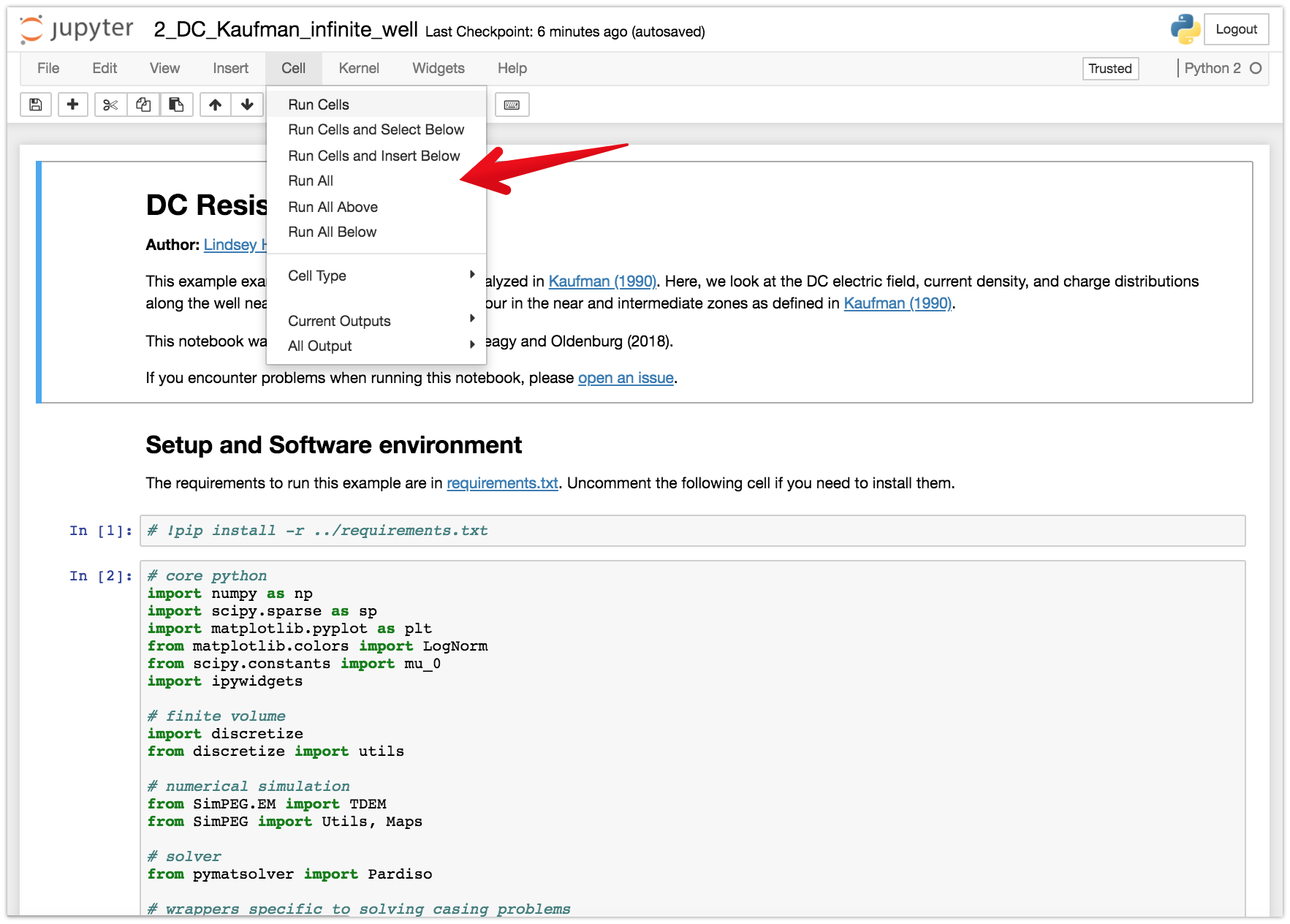| Overview | Citation | Launching the notebooks | Running the notebooks | Issues | License |
These notebooks were used to perform the analysis and generate the figures shown "Direct current resistivity with steel-cased wells" by Lindsey Heagy and Doug Oldenburg published in Geophysical Journal International, as well as that shown in Chapter 4 of the thesis Electromagnetic imaging of subsurface injections.
We examine the use of DC resistivity for detecting flaws in a well in a casing integrity experiment, and examine factors influencing our ability to excite and detect a target at depth.
Heagy, L. J., & Oldenburg, D. W. (2018). Direct current resistivity with steel-cased wells. Geophysical Journal International.
@article{10.1093/gji/ggz281,
author = {Heagy, Lindsey J and Oldenburg, Douglas W},
title = "{Direct current resistivity with steel-cased wells}",
journal = {Geophysical Journal International},
year = {2019},
month = {06},
issn = {0956-540X},
doi = {10.1093/gji/ggz281},
url = {https://doi.org/10.1093/gji/ggz281},
eprint = {http://oup.prod.sis.lan/gji/advance-article-pdf/doi/10.1093/gji/ggz281/28836831/ggz281.pdf},
}
-
1_DC_Flawed_Steel_Cased_Wells.ipynb
- examines the feasibility of using DC resistivity for detecting a flaw in a steel-cased well and investigates the impact of parameters such as the background conductivity on our ability to detect a flaw from data collected at the surface.
- This notebook was used to produce:
- Figures 1, 2, 4, 5, 6, 9, 10, 11 in Heagy & Oldenburg (2018)
- Figures 4.1, 4.2, 4.4, 4.5, 4.6, 4.9, 4.10 and 4.11 in the thesis
-
2_DC_Flawed_Steel_Cased_Wells_Short_well.ipynb
- looks at hte impact of the vertical extent of the flaw on the distribution of charges.
- Used to produce:
- Figure 3 in Heagy & Oldenburg (2018)
- Figure 4.3 in the thesis
-
3_DC_Flawed_Steel_Cased_Wells_layer
- looks at the impact of a conductive or resistive layer on our ability to detect a flaw.
- Used to create:
- Figures 7, 8 in Heagy & Oldenburg (2018)
- Figures 4.7 and 4.8 in the thesis
-
- looks at the impact of the source electrode location on our ability to deliver current to depth.
- This was used to produce:
- Figures 12, 13 in Heagy & Oldenburg (2018)
- Figures 4.12 and 4.13 in the thesis
-
- Examines our ability to excite a conductive or resistive target at depth, looks at the impact of having an electrical connection (or not) between the target and the casing
- This notebook was used to produce:
- Tables 1, 2 and Figures 14, 15, 16, 17, 18 in Heagy & Oldenburg (2018)
- Tables 4.1, 4.2 and Figures 4.14, 4.15, 4.16, 4.17, 4.18 in the thesis
-
6_DC_target_3D_cartesian.ipynb
- here, we use a born approximation approach to examine our ability to excite a target offset from the well.
- This notebook was used to produce:
- Figures 19, 20, 21 in Heagy & Oldenburg (2018)
- Figures 4.19, 4.20, 4.21 in the thesis
-
7_DC_Approximating_Steel_Cased_Wells.ipynb
- This notebook looks at approximations of a steel cased well by a solid cylinder, either with a conductivity equal to steel, or a conductivity that preserves the cross-sectional conductance of the well.
- This notebook was used to produce:
- Figures 22, 23 in Heagy & Oldenburg (2018)
- Figures 4.22, 4.23 in the thesis
-
8_DC_Approximating_Steel_Cased_Wells_layered_background.ipynb
- Similar to notebook 7, this notebook looks at approximations to the steel cased well by a solid cylinder in a layered background.
- It was used to produce:
- Figures 24, 25 in Heagy & Oldenburg (2018)
- Figures 4.24, 4.25 in the thesis
-
9_DC_Approximating_Steel_Cased_Wells_Cartesian.ipynb
- This notbook looks at approximations of the steel cased well onto a cartesian mesh.
- This notebook was used to create:
- Figure 26 in Heagy & Oldenburg (2018)
- Figures 4.26 in the thesis
The notebooks can be run online through mybinder or azure notebooks.
To run them locally, you will need to have python installed, preferably through anaconda.
You can then clone this repository. From a command line, run
git clone https://github.com/simpeg-research/heagy-2018-dc-casing.git
Then cd into the heagy-2018-dc-casing
cd heagy-2018-dc-casing
To setup your software environment, we recommend you use the provided conda environment
conda env create -f environment.yml
source activate dc-casing-environment
alternatively, you can install dependencies through pypi
pip install -r requirements.txt
You can then launch Jupyter
jupyter notebook
Jupyter will then launch in your web-browser.
Each cell of code can be run with shift + enter or you can run the entire notebook by selecting cell, Run All in the toolbar.
For more information on running Jupyter notebooks, see the Jupyter Documentation
If you run into problems or bugs, please let us know by creating an issue in this repository.
These notebooks are licensed under the MIT License which allows academic and commercial re-use and adaptation of this work.
Current version: 0.0.3




